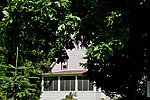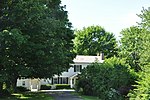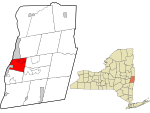The Manor of Rensselaerswyck, Manor Rensselaerswyck, Van Rensselaer Manor, or just simply Rensselaerswyck (Dutch: Rensselaerswijck Dutch pronunciation: [ˈrɛnsəlaːrsˌʋɛik]), was the name of a colonial estate—specifically, a Dutch patroonship and later an English manor—owned by the van Rensselaer family that was located in the area that would later become the Capital District of New York in the United States.
The estate was originally deeded by the Dutch West India Company in 1630 to Kiliaen van Rensselaer, a Dutch merchant and one of the company's original directors. Rensselaerswyck extended for miles on each side of the Hudson River. It included most of the land that would later become New York counties of Albany and Rensselaer, as well as parts of Columbia and Greene counties.
Under the terms of the patroonship, the patroon had nearly total jurisdictional authority, establishing civil and criminal law, villages, and a church (in part to record vital records, which were not kept by the state until the late 19th century). Tenant farmers were allowed to work on the land, but had to pay rent to the owners and had no property rights. In addition, the van Rensselaers harvested timber from the property.
The patroonship was maintained intact by van Rensselaer descendants for more than two centuries. At the time of his death in 1839, Steven van Rensselaer III's land holdings made him the tenth-richest American in history. His son Stephen Van Rensselaer IV, the 10th and last patroon, received the bulk of his holdings; son William received some lands east of the Hudson. Following the death of Steven van Rensselaer III, tenant farmers began protesting the manor system. Under financial, judicial, and political pressure from this anti-rent movement, Stephen IV and William van Rensselaer sold off most of their land, ending the patroonship in the 1840s. For length of operations, the van Rensselaer patroonship was the most successful patroonship established under the West India Company system.









